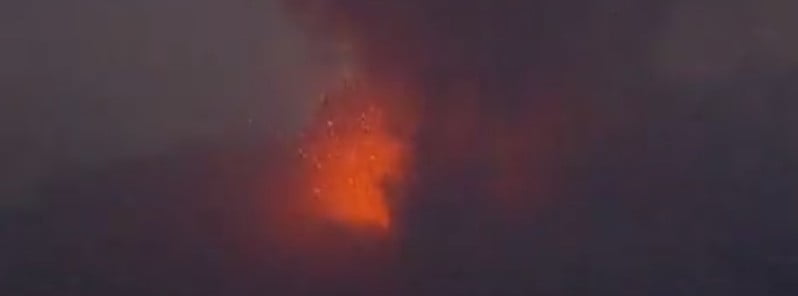Strong eruption at Sakurajima volcano, Volcanic Alert Level raised to 5, evacuations ordered, Japan

A strong explosive eruption took place at Sakurajima volcano, Japan at 20:05 LT (11:05 UTC) on July 24, 2022, prompting the Japan Meteorological Agency (JMA) to raise the Volcanic Alert Level from 3 to 5 and urge residents living within 3 km (1.8 miles) from the volcano to evacuate.
JMA said the eruption took place at Minamidake crater shortly after 20:00 LT, throwing large volcanic rocks as far as 2.5 km (1.5 miles) away.
While major eruption is not expected, JMA urged some 120 residents living in the danger zone to evacuate.
The agency warned of falling volcanic rocks within 3 km (1.8 miles) from the crater and possible flow of lava, ash and searing gas within 2 kilometers (1.2 miles).1
Locals are advised to pay attention to updates from local authorities.
The video below was captured on July 17:
Geological summary
The Aira caldera in the northern half of Kagoshima Bay contains the post-caldera Sakurajima volcano, one of Japan’s most active. Eruption of the voluminous Ito pyroclastic flow accompanied the formation of the 17 x 23 km (10.5 x 14.3 miles) caldera about 22 000 years ago. The smaller Wakamiko caldera was formed during the early Holocene in the NE corner of the Aira caldera, along with several post-caldera cones.
The construction of Sakurajima began about 13 000 years ago on the southern rim of Aira caldera and built an island that was finally joined to the Osumi Peninsula during the major explosive and effusive eruption of 1914. Activity at the Kitadake summit cone ended about 4 850 years ago, after which eruptions took place at Minamidake.
Frequent historical eruptions, recorded since the 8th century, have deposited ash on Kagoshima, one of Kyushu’s largest cities, located across Kagoshima Bay only 8 km (5 miles) from the summit. The largest historical eruption took place during 1471-76.2
References:
1 Sakurajima volcano activity update – JMA – July 24, 2022
2 Sakurajima – Geological summary – GVP
Featured image credit: JMA

DURING THE RAPID SHIFT OF EARTH’S MAGNETIC FIELD, NUCLEAR POWER PLANTS POSE THE GREATEST THREAT
The nuclear facility on Japan’s western major island of Kyushu is located some 50 km (31 miles) northwest of Sakurajima, a volcano that erupted at about 8:05 p.m. (1105 GMT). However, in the coming months many earthquakes and volcanic eruptions will take place around the globe, especially around the ring of fire. Thus, Japan must face the reality and shutdown its nuclear power plants.
Japanese volcanologists and geologists know that the number of earthquakes around many volcanoes have increased dramatically over the last two years and many of those volcanoes are on the verge of eruption, just like Mount Fuji https://lnkd.in/ddcqJkja and the same thing applies to the biggest volcanoes in the US.